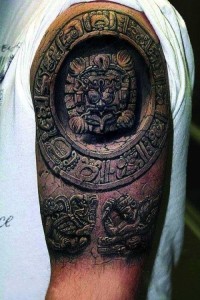
1. Give the image some serious thought. There are tons of reasons to get a tattoo: An inspirational friend or family member, a big life event, or just for the sake of art, but when you’re thinking about getting a tattoo, make sure you’re putting how it looks before what it means. Why? Because a) people aren’t always going to ask you what your tattoo means, and b) it’s a picture on your body. You want it first and foremost to look good.
2. Choose proper placement. This is a compositional element I think a lot of people don’t think about. For example, a tattoo can be distorted by placement on a body part that will stretch with pregnancy. Other concerns could be future employment and professional appearance. Hand and neck tattoos are said to be deal-breakers in the corporate job market, so take that into consideration. Finally, a tattoo can really flatter or distort a muscle depending on placement. For women whose features are often more dainty than mens, a tattoo sleeve that reaches all the way around the shoulder can make a woman appear to be more muscular and masculine. It’s not a rule to live or die by, just something to consider. Tattoos draw attention to themselves inherently. Where you put them is just as important as the images themselves.
3. Decide on your aesthetic. This is especially important if you plan on getting more and more tattoos. There are tons of different styles of tattoo art, from very stylized to super-realistic; black and grey to full-color, the sky is the limit. It’s imperative that you get a clear idea of what you want not only so you can convey it to your artist, but also to help you choose an artist.
4. Choose an artist wisely. Tattoo artists have different strengths and interests. In one shop you might find an artist who loves detail while another is great with Sailor Jerry style. It’s easy to search artists in your area because they usually have a really great online presence — after all, they are trying to build their business. You can also ask people whose tattoos catch your eye where they got there’s done. Once you’ve found your artist and made an appointment, they’ll often consult with you about your tattoo. If you’re unsure, deferring to their instincts on composition can both ensure that your tattoo will translate well on your skin, but that it will be something that your artist considers him or herself to be good at. However, if you feel that you’re getting pushed in the wrong direction by artistic differences with your artist, definitely try someone else. A tattoo is going to be on your skin for the rest of your life, most likely. It’s better to get exactly what you want than to worry about being polite. And I’ll bet they don’t want to tattoo someone who won’t like their style, either. So it’s beneficial to just be honest and straight-forward with your artist.
5. Take care of your new tattoo. Tattoos peel and do all sorts of strange things when they’re fresh. Your artist will probably saran-wrap your new ink and prescribe a regimen of non-irritating soap and a good moisturizer. Mine told me to use Aquaphor and it worked like a charm. I have seen the other side of it, as I’m sure many have. Tattoos in places that are easily rubbed by clothing or shoes are asking for after-care mishaps. I once had a friend who had her instep tattooed. Her flip-flops turned her dolphin tattoo into kind of a permanent bruise-looking thing. At least it was only her foot. But there is a lot to be said for protecting your investment while it’s fresh, keeping it protected from the sun, and keeping it moisturized so it always looks great.
BY KACKIE




